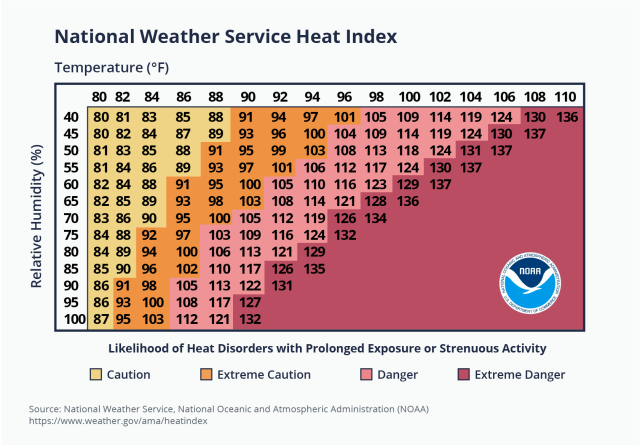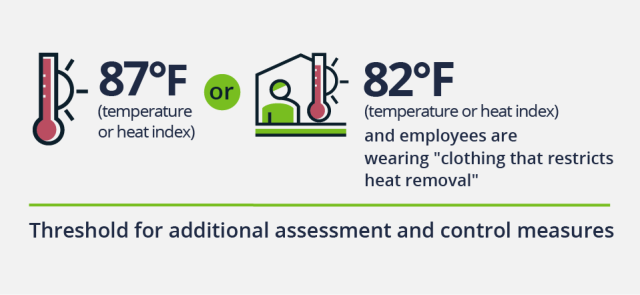Blog
How California OSHA’s Proposed Indoor Heat Illness Prevention Regulations May Affect Employers
Learn about California’s new indoor heat illness prevention standard, how it will affect employers, and how the standard is similar to the proposed Federal OSHA standard.
With regulators continuing to concentrate on heat and heat illness prevention, it’s no surprise that California OSHA recently sent a new indoor heat illness regulation to the Office of Administrative Law for review and sign off. Some of the key elements of this new regulation, as it currently reads, include the following:
- Once an indoor workplace exceeds the initial trigger of 82 degrees Fahrenheit (F), several provisions in the regulation are triggered.
- If 87 degrees F or a heat index of 87 degrees F is reached, additional measures including acclimatization and ongoing measurements and controls are triggered.
- The need to utilize what California OSHA terms as “clothing that restricts heat removal” lowers the trigger temperature for acclimatization, as well as ongoing measurement and controls, to 82 degrees F or a heat index of 82 degrees F.
- In general, this regulation relies heavily on heat index measurements and limits rather than plain temperature measurements.
- Accounts for both weather-related heat (in indoor workplaces without effective engineering controls in place) and process-generated radiant heat sources

This article further examines California’s proposed standard, how it will affect employers, and how the standard is similar to the proposed Federal OSHA standard being promulgated.
What Are California's Heat Illness Standards?
California OSHA is rolling out a separate indoor heat illness standard in addition to the outdoor heat illness prevention regulation that has been in place for several years. California is not the only state to have its own heat illness regulation. Washington, Minnesota, and Oregon now all have their own state specific heat illness prevention regulations in place, and Federal OSHA is promulgating a similar regulation.
California’s outdoor heat illness regulation has been in emergency and then permanent form since 2005. Additional research into heat illness incidents associated with indoor work between 2010 and 2018 caused a resurgence in interest in developing a new indoor heat illness standard.
There are some differences between the new indoor standard (Title 8, 3396, Heat Illness Prevention in Indoor Places of Employment) and the existing outdoor standard (Title 8, 3395, Heat Illness Prevention in Outdoor Places of Employment), and employers may require a bit of adjustment when trying to comply with the new standard.
For example, the current outdoor standard focuses on degrees Fahrenheit only, while the new proposed indoor standard references both temperature in degrees Fahrenheit as an initial trigger and then degrees Fahrenheit heat index further into the standard. Heat index takes humidity into account and is found using the temperature in degrees Fahrenheit along with the percentage of relative humidity, and by plotting the heat index on the National Weather Service heat index chart. It can also be measured using instruments that account for both temperature and humidity. From the chart below it is easy to see that even when the temperature is only 82 degrees F, depending on the humidity (75% or more) the heat index temperature can easily hit and exceed 87 degrees, pushing the workplace into the full requirements of this regulation.

After the inital trigger in degrees Fahrenheit is exceeded, anywhere the new standard references a temperature such as 87 degrees Fahrenheit, it also requires measurement and recording in heat index degrees. Since humidity is considered in heat index degrees and acts as a multiplier of sorts this will make workplaces which are warm and have elevated humidity levels more likely to be required to comply with the added pieces of this regulation.
The use of heat index numbers in the new standard could indicate a desire by California OSHA to include the same measurement requirement in the outdoor standard at some point in the future.
So, what exactly is clothing that restricts heat removal? Secondary to the fact that using this type of clothing lowers the trigger for full compliance with all elements of the regulation, it’s important to fully understand what this clothing is and isn’t.
| The new indoor standard outlines a specific definition: |
|
"Clothing that restricts heat removal” means full-body clothing covering the arms, legs, and torso that is any of the following: (A) Waterproof; or (B) Designed to protect the wearer from a chemical, biological, physical, radiological, or fire hazard; or (C) Designed to protect the wearer or the work process from contamination. There is an exception: “Clothing that restricts heat removal” does not include clothing with flame or arc-flash resistant properties demonstrated by the employer to be all of the following:
|
Expanded Heat Illness Assessment Procedures
Once a workplace reaches temperatures or a heat index of 87 degrees F, or 82 degrees F and employees are wearing “clothing that restricts heat removal,” the standard requires additional assessment and control measures to be completed.
Employers must continue to measure heat index, but it doesn’t stop there. Somewhat parallel to the outdoor regulation standard requirements for “high heat procedures," the measures include assessment procedures such as:
- Identifying and evaluating other environmental risk factors for heat illness
- Keeping records of all measurements taken
- Taking measurements during the time of greatest exposure
- Taking measurements when it is suspected that measurements may be 10 degrees or more above the latest set of measurements
- Retaining measurement records for 12 months or until the next set of measurements is taken, whichever is later
- Using instruments that utilize the NWS heat index tables to measure heat index

At the end of the assessment section, employers are given an option of having active employee and employee representative involvement in the planning, conducting, and recording of measurements as well as identifying and evaluating other risk factors. Alternatively, the employer may assume that a work area falls under these control requirements and apply Section (e)(1) controls regardless.
Controls and Response: Comparing the Indoor and Outdoor Standards
Section (e)(2) outlines engineering controls, administrative controls, and personal heat protective equipment in ranked order of preference. For example, if an employer wishes to bypass engineering controls in favor of administrative controls or personal heat-protective equipment, they must be able to establish the infeasibility of the higher-ranked engineering control.
The emergency response section of the proposed standard is almost identical to the outdoor heat illness standard and requires effective communication with employees, supervisors, and emergency medical services. These plans will help to ensure an employee can be accessed by emergency medical providers, and that accurate directions to the workplace are given to emergency providers. The emergency response section also requires planning for and appropriate response to signs and symptoms of heat illness, including providing first aid and medical services and ensuring the affected employee is monitored and not left alone without being offered first aid or medical treatment as appropriate.
California OSHA has provided a side-by-side comparison of the outdoor and indoor heat illness regulations. That comparison can be found on their heat illness information page.
Section (h) of the indoor heat illness regulation includes training topics for both employees and supervisors. These topics are identical to the training requirements found in the outdoor standard. However, allowances are made for the fact that shade is not a factor indoors and that weather monitoring may not play as large a role in some indoor workplaces.
Water provision, including a specific volume per employee per hour and a requirement for the water to be suitably cool, is included in both standards.
While shade is not a prominent topic in the indoor regulation, free access to a cool-down area is. Like in the outdoor regulation, employees must be allowed to access the area at all times, be monitored when in the area, encouraged to stay in the area, and not ordered back to work for at least five minutes and then only if all heat illness symptoms have abated.
The new indoor standard addresses acclimatization during heat waves by requiring close observation of employees if effective engineering controls for indoor temperatures are not in place. It also requires 14 days of close observation of newly assigned employees in workplaces where the indoor temperature or heat index equals or exceeds 87 degrees F or 82 degrees F in workplaces where employees must wear "clothing that restricts heat removal" or who work in high-radiant-heat areas.
If the 82 Degree Fahrenheit Temperature Trigger Is Exceeded, Employers Will Need a Written Program
The written portion of this program can be included as part of the IIPP (Injury and Illness Prevention Program) or as part of a separate heat illness prevention plan. The written plan minimums include the following procedures:
- Provision of water as outlined in the regulation
- Access to cool-down areas as outlined in the regulation
- Measurement of temperature and heat index as well as risk factor evaluation and control measures as outlined in the regulation
- Emergency response
- Close monitoring during acclimatization
A California OSHA combination outdoor and indoor heat illness program template can be found here.
For employers with warm indoor spaces, particularly for those with high humidity, radiant heat sources, and requirements for protective clothing, this standard may present both engineering and compliance challenges.
For additional resources from California OSHA visit their informational resource page and start with their informational fact sheet for employers.
Federal OSHA Proposes Similar Regulations
The new California heat illness regulations mirror some of the elements found in a proposed federal standard. The inclusion of indoor heat illness prevention provisions and the use of heat index measurements instead of straight temperature measurements are two of those reflective provisions. The text of the proposed federal regulation can be reviewed on regulations.gov.
The proposed federal regulation appears to be in development to allow for easier and more specific enforcement of heat illness prevention measures. Currently, Federal OSHA is forced to rely on the general duty clause when issuing citations.
Since 2011, Federal OSHA has had a national emphasis program in place around heat illness prevention. That national emphasis program has resulted in more enforcement action including citations and site visits focused on heat illness prevention programming and the program is likely to continue into at least 2025. Employers with locations in Federal OSHA states may wish to review this article written about that program and the OSHA summary of the national emphasis program to learn more about industries being targeted, enforcement instructions for duty officers, and when employers might expect enforcement visits to occur.
If you have questions about these new proposals or other OSHA standards, contact your Woodruff Sawyer account team.
Author
Table of Contents












